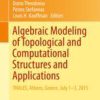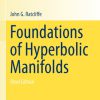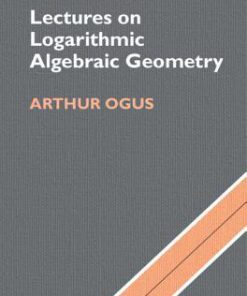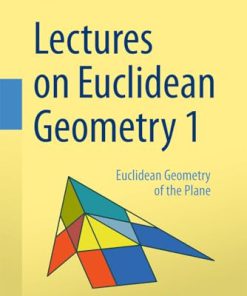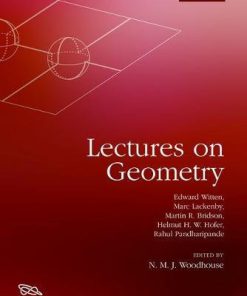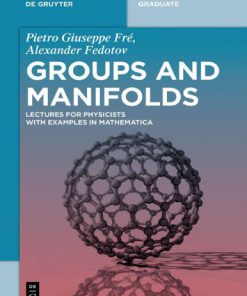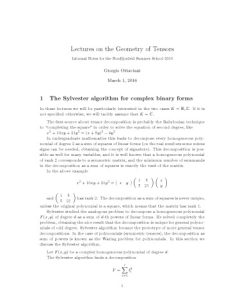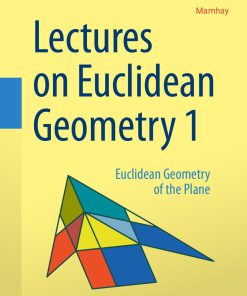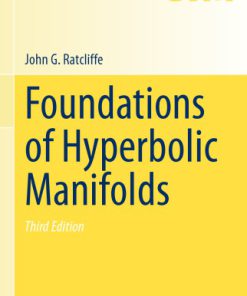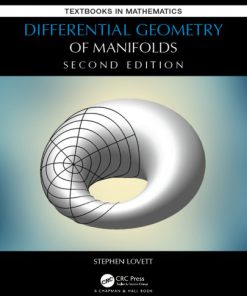Lectures on the Geometry of Manifolds 3rd Edition by Liviu Nicolaescu 9789811215957 9811215952
$50.00 Original price was: $50.00.$25.00Current price is: $25.00.
Lectures on the Geometry of Manifolds 3rd Edition by Liviu Nicolaescu – Ebook PDF Instant Download/Delivery:9789811215957,9811215952
Full download Lectures on the Geometry of Manifolds 3rd Edition after payment
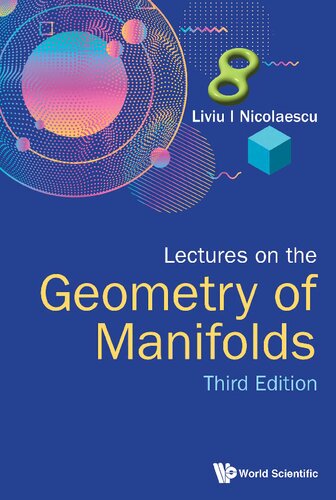
Product details:
ISBN 10:9811215952
ISBN 13:9789811215957
Author:Liviu Nicolaescu
The goal of this book is to introduce the reader to some of the main techniques, ideas and concepts frequently used in modern geometry. It starts from scratch and it covers basic topics such as differential and integral calculus on manifolds, connections on vector bundles and their curvatures, basic Riemannian geometry, calculus of variations, DeRham cohomology, integral geometry (tube and Crofton formulas), characteristic classes, elliptic equations on manifolds and Dirac operators. The new edition contains a new chapter on spectral geometry presenting recent results which appear here for the first time in printed form.
Lectures on the Geometry of Manifolds 3rd Table of contents:
1. Manifolds
1.1 Preliminaries
1.1.1 Space and Coordinatization
1.1.2 The implicit functiontheorem
1.2 Smoothmanifolds
1.2.1 Basic definitions
1.2.2 Partitions of unity
1.2.3 Examples
1.2.4 How many manifolds are there?
2. Natural Constructions on Manifolds
2.1 The tangent bundle
2.1.1 Tangent spaces
2.1.2 The tangent bundle
2.1.3 Transversality
2.1.4 Vector bundles
2.1.5 Some examples of vector bundles
2.2 A linear algebra interlude
2.2.1 Tensor products
2.2.2 Symmetric and skew-symmetric tensors
2.2.3 The ”super” slang
2.2.4 Duality
2.2.5 Some complex linear algebra
2.3 Tensor fields
2.3.1 Operations with vector bundles
2.3.2 Tensor fields
2.3.3 Fiber bundles
3. Calculus on Manifolds
3.1 The Lie derivative
3.1.1 Flows on manifolds
3.1.2 The Lie derivative
3.1.3 Examples
3.2 Derivations of Ω• (M)
3.2.1 The exterior derivative
3.2.2 Examples
3.3 Connections on vector bundles
3.3.1 Covariant derivatives
3.3.2 Parallel transport
3.3.3 The curvature of a connection
3.3.4 Holonomy
3.3.5 The Bianchi identities
3.3.6 Connections on tangent bundles
3.4 Integration on manifolds
3.4.1 Integration of 1-densities
3.4.2 Orientability and integration of differential forms
3.4.3 Stokes’ formula
3.4.4 Representations and characters of compact Lie groups
3.4.5 Fibered calculus
4. Riemannian Geometry
4.1 Metric properties
4.1.1 Definitions and examples
4.1.2 The Levi–Civita connection
4.1.3 The exponential map and normal coordinates
4.1.4 The length minimizing property of geodesics
4.1.5 Calculus on Riemann manifolds
4.2 The Riemann curvature
4.2.1 Definitions and properties
4.2.2 Examples
4.2.3 Cartan’s moving frame method
4.2.4 The geometry of submanifolds
4.2.5 Correlators and their geometry
4.2.6 The Gauss–Bonnet theorem for oriented surfaces
5. Elements of the Calculus of Variations
5.1 The least action principle
5.1.1 The 1-dimensional Euler–Lagrange equations
5.1.2 Noether’s conservation principle
5.2 The variational theory of geodesics
5.2.1 Variational formulae
5.2.2 Jacobi fields
5.2.3 The Hamilton-Jacobi equations
6. The Fundamental Group and Covering Spaces
6.1 The fundamental group
6.1.1 Basic notions
6.1.2 Of categories and functors
6.2 Covering Spaces
6.2.1 Definitions and examples
6.2.2 Unique lifting property
6.2.3 Homotopy lifting property
6.2.4 On the existence of lifts
6.2.5 The universal cover and the fundamental group
7. Cohomology
7.1 DeRham cohomology
7.1.1 Speculations around the Poincaré lemma
7.1.2 Čech vs. DeRham
7.1.3 Very little homological algebra
7.1.4 Functorial properties of the DeRham cohomology
7.1.5 Some simple examples
7.1.6 The Mayer-Vietoris principle
7.1.7 The Kunneth formula
7.2 The Poincaré duality
7.2.1 Cohomology with compact supports
7.2.2 The Poincaré duality
7.3 Intersection theory
7.3.1 Cycles and their duals
7.3.2 Intersection theory
7.3.3 The topological degree
7.3.4 The Thom isomorphism theorem
7.3.5 Gauss–Bonnet revisited
7.4 Symmetry and topology
7.4.1 Symmetric spaces
7.4.2 Symmetry and cohomology
7.4.3 The cohomology of compact Lie groups
7.4.4 Invariant forms on Grassmannians and Weyl’s integral formula
7.4.5 The Poincaré polynomial of a complex Grassmannian
7.5 Čech cohomology
7.5.1 Sheaves and presheaves
7.5.2 Čech cohomology
8. Characteristic Classes
8.1 Chern–Weil theory
8.1.1 Connections in principal G-bundles
8.1.2 G-vector bundles
8.1.3 Invariant polynomials
8.1.4 The Chern–Weil Theory
8.2 Important examples
8.2.1 The invariants of the torus Tn
8.2.2 Chern classes
8.2.3 Pontryagin classes
8.2.4 The Euler class
8.2.5 Universal classes
8.3 Computing characteristic classes
8.3.1 Reductions
8.3.2 The Gauss–Bonnet–Chern theorem
9. Classical Integral Geometry
9.1 The integral geometry of real Grassmannians
9.1.1 Co-area formulae
9.1.2 Invariant measures on linear Grassmannians
9.1.3 Affine Grassmannians
9.2 Gauss–Bonnet again?!?
9.2.1 The shape operator and the second fundamental form
9.2.2 The Gauss–Bonnet theorem for hypersurfaces of an Euclidean space
9.2.3 Gauss–Bonnet theorem for domains in an Euclidean space
9.3 Curvature measures
9.3.1 Tame geometry
9.3.2 Invariants of the orthogonal group
9.3.3 The tube formula and curvature measures
9.3.4 Tube formula ⇒ Gauss–Bonnet formula for arbitrary submanifolds of an Euclidean space
9.3.5 Curvature measures of domains in an Euclidean space
9.3.6 Crofton formulae for domains of an Euclidean space
9.3.7 Crofton formulae for submanifolds of an Euclidean space
10. Elliptic Equations on Manifolds
10.1 Partial differential operators: algebraic aspects
10.1.1 Basic notions
10.1.2 Examples
10.1.3 Formal adjoints
10.2 Functional framework
10.2.1 Sobolev spaces in RN
10.2.2 Embedding theorems: integrability properties
10.2.3 Embedding theorems: differentiability properties
10.2.4 Functional spaces on manifolds
10.3 Elliptic partial differential operators: analytic aspects
10.3.1 Elliptic estimates in RN
10.3.2 Elliptic regularity
10.3.3 An application: prescribing the curvature of surfaces
10.4 Elliptic operators on compact manifolds
10.4.1 Fredholm theory
10.4.2 Spectral theory
10.4.3 Hodge theory
11. Spectral Geometry
11.1 Generalized functions and currents
11.1.1 Generalized functions and operations withy them
11.1.2 Currents
11.1.3 Temperated is tributions and the Fourier transform
11.1.4 Linear differential equations with distributional data
11.2 Important families of generalized functions
11.2.1 Some classical generalized functions on the real axis
11.2.2 Homogeneous generalized functions
11.3 The wave equation
11.3.1 Fundamental solutions of the wave
11.3.2 The wave family
11.3.3 Local parametrices for the wave equation with variable coefficients
11.4 Spectral geometry
11.4.1 The spectral function of the Laplacian on a compact manifold
11.4.2 Short time asymptotics for the wave kernel
11.4.3 Spectral function asymptotics
11.4.4 Spectral estimates of smoothing operators
11.4.5 Spectral perestroika
12. Dirac Operators
12.1 The structure of Dirac operators
12.1.1 Basic definitions and examples
12.1.2 Clifford algebras
12.1.3 Clifford modules: the even case
12.1.4 Clifford modules: the odd case
12.1.5 A look ahead
12.1.6 The spin group
12.1.7 The complex spin group
12.1.8 Low dimensional examples
12.1.9 Dirac bundles
12.2 Fundamental examples
12.2.1 The Hodge–DeRham operator
12.2.2 The Hodge–Dolbeault operator
12.2.3 The spin Dirac operator
12.2.4 The spinc Dirac operator
People also search for Lectures on the Geometry of Manifolds 3rd :
lectures on the geometry of flag varieties
lectures on the geometric anatomy of theoretical physics problem sheet
lectures on the geometry of numbers
lectures on the geometric anatomy of theoretical physics
lectures on the geometric anatomy of theoretical physics pdf
Tags:
Liviu Nicolaescu,Geometry,Manifolds,Lectures
You may also like…
Mathematics - Geometry and Topology
Lectures on Euclidean Geometry – Volume 1: Euclidean Geometry of the Plane 1st Edition Pamfilos
Mathematics
Uncategorized
Mathematics - Geometry and Topology
Lectures on Euclidean Geometry: Euclidean Geometry of the Plane Paris Pamfilos
Mathematics - Geometry and Topology
Foundations of Hyperbolic Manifolds 3rd Edition by John Ratcliffe ISBN 9783030315979 3030315975


